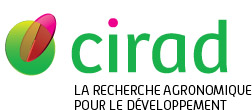Serrano-León Hernán, Blondeel Haben, Bonal Damien, Grossiord Charlotte, Martin Nicolas, Guillemot Joannès, Van den Bulcke Jan, Glenz Paula, Steurer Johannes, Gong Jialiang, Skiadaresis Georgios, Decarsin Renaud, Gheyle Toon, Baeten Lander, Scherer-Lorenzen Michael, Bauhus Jürgen.
2024. Drought resilience in mixed forest plantations: interactive effects of functional trait diversity, tree size and competition.
In : IUFRO 2024 World Congress: Forests and Society Towards 2050. Book of abstracts. IUFRO, Swedish University of Agricultural Sciences
|
Version publiée
- Anglais
Utilisation soumise à autorisation de l'auteur ou du Cirad. 612671.pdf Télécharger (737kB) | Prévisualisation |
Résumé : Mixing tree species has been proposed as a potential solution to mitigate the impacts of rising drought stress in forest ecosystems while providing a wider range of ecosystem functions and services than dominant monocultures. However, it is still unclear how increasing tree diversity improves tree resilience to drought across different species and biotic and abiotic contexts (e.g. mixture composition, climate or degree of soil drought). Here, we investigated how the diversity of tree species and functional traits affects the drought responses of tree radial growth, wood density, and carbon isotope composition (Δδ13C, as a proxy for water use efficiency). We collected wood increment cores of 21 tree species growing in monocultures and mixtures (2- and 4-species) in nine experimental sites across Europe, belonging to the global network of forest biodiversity experiments (TreeDivNet). These experiments cover a wide gradient in climatic conditions, reflected in the forest types they represent (from boreal to temperate and Mediterranean). We determined the intensity of recent drought events based on the Standardized Precipitation Evapotranspiration Index (SPEI) and water availability outputs of the soil-plant-atmosphere hydraulic model SurEau. We obtained wood density and tree-ring width series using X-ray micro-Computed Tomography (μCT) and assessed the drought-induced responses of radial tree growth in terms of resistance, recovery, and resilience. We investigated how tree drought responses and water use efficiency varied depending on the tree species identity, the diversity of functional traits in the neighbourhood and the local climate. In addition, we analysed how the effect of tree diversity on the individual tree responses and community responses was mediated by drought intensity, tree size, and neighbourhood competition index. Our results indicate that selecting appropriate combinations of tree species is crucial for improving forest resilience to drought events. The identified mechanisms emphasize the importance of increasing the diversity and complementarity of functional traits to adapt forests to drought risks and thus provide more robust restoration approaches in the face of climate change.
Auteurs et affiliations
- Serrano-León Hernán, Universität Freiburg (DEU)
- Blondeel Haben, Ghent University (BEL)
- Bonal Damien, Université de Lorraine (FRA)
- Grossiord Charlotte, EPFL (CHE)
- Martin Nicolas, INRAE (FRA)
-
Guillemot Joannès, CIRAD-PERSYST-UMR Eco&Sols (FRA)
 ORCID: 0000-0003-4385-7656
ORCID: 0000-0003-4385-7656
- Van den Bulcke Jan, Ghent University (BEL)
- Glenz Paula, Universität Freiburg (DEU)
- Steurer Johannes, Universität Freiburg (DEU)
- Gong Jialiang, Universität Freiburg (DEU)
- Skiadaresis Georgios, Universität Freiburg (DEU)
- Decarsin Renaud, CIRAD-PERSYST-UMR Eco&Sols (FRA)
- Gheyle Toon, Ghent University (BEL)
- Baeten Lander, Ghent University (BEL)
- Scherer-Lorenzen Michael, Universität Freiburg (DEU)
- Bauhus Jürgen, Universität Freiburg (DEU)
Source : Cirad-Agritrop (https://agritrop.cirad.fr/612671/)
[ Page générée et mise en cache le 2025-03-27 ]




